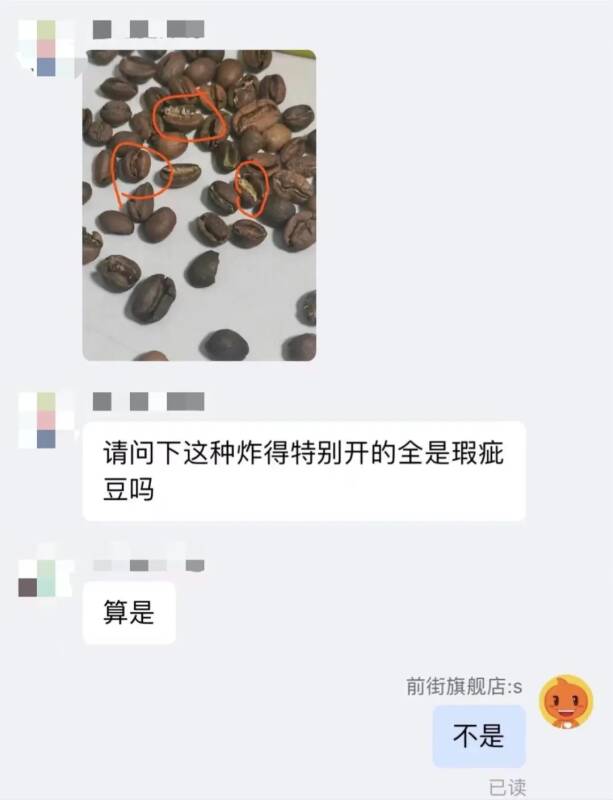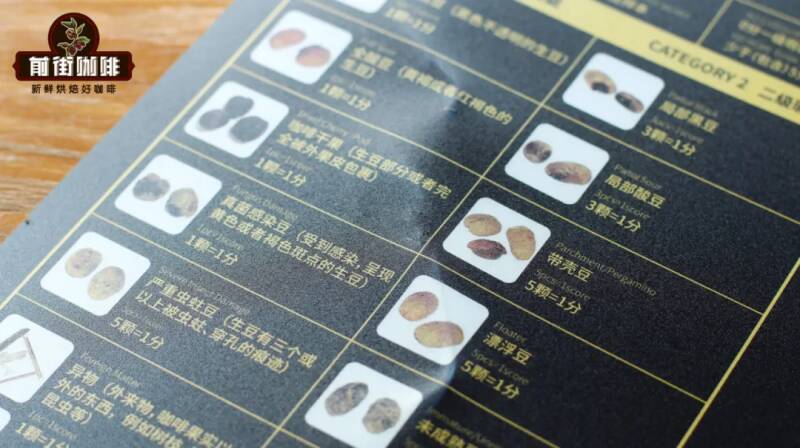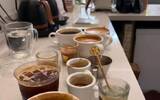Classification standard for coffee blemished beans What common raw coffee beans are defective beans do I need to pick beans before making coffee?
Because the main business of Qianjie is selling beans, in addition to a series of problems in brewing and making coffee, the backstage often receives some feedback about beans. For example, the problem of defective beans. Some guests and friends will take the picture to Qianjie and ask if the beans in the photo are defective. But basically, in the photos I saw on the front street, nearly 90% of the beans were not defective.

The reason why so many friends have frequent misunderstandings is that there is a certain misunderstanding about the definition of defective beans. For example, it is thought that roasted coffee beans will be like industrial products, with roughly the same appearance: round, plump, smooth. Of course, it is more because people have not formally come into contact with defective beans. Because the information is very developed now, we can see a lot of information about coffee beans on the Internet, including defective beans. Such as moth-eaten beans, moldy beans with mold, immature Quick beans, and so on. Although they all come with corresponding pictures, after all, they have never really seen the real thing, so most friends can only remember some simple definitions and the names of defective beans.

In fact, defective beans are mainly concentrated in raw beans, and for the vast majority of consumers, the chance to come into contact with them is very small. First of all, one reason is that most coffee producing areas screen defective beans when exporting coffee beans, because coffee beans in those countries are graded on the basis of defect rate. When the bean defect rate is lower, the higher the grade, the higher the grade, the more expensive it can be sold. In order to better sell the high price, raw bean merchants will specially screen the defective coffee beans. Roasters will also give priority to purchasing high-grade coffee beans in order to ensure the quality of beans and save time in sieving beans. So when the raw beans are in their hands, they have already carried out a screening, and the proportion of defects in the raw beans is very small.
Even if there are a small number of defective beans, most of the defective beans will have a serious negative impact on the whole cup of coffee experience, and no roaster will do anything to destroy their reputation for convenience. So before baking, most roasters will screen the raw coffee beans to remove defective beans to ensure that the products have a good quality.
However, it is inevitable that there will be some defective beans that are difficult to catch before baking, such as white beans, as well as defective beans produced in the baking process. So in this case, Qianjie's approach is to manually screen the coffee beans after they have been roasted to remove these flaws that affect the experience. Then it is weighed and packaged and sent to the buyer. So we can know that when the whole link comes down, consumers have little chance of being exposed to what is considered to be major defective beans in the industry.
What we need to know is that a bag of beans is not completely free of defective beans, but there are few defective beans that seriously affect the taste (for most businesses). There are more broken beans that are broken because of bumps in the course of transportation. They are just incomplete and do not affect the overall taste of the coffee. (those beans with irregular cracks) then, let's share those beans that are often misunderstood, seemingly flawed, but not defective beans.
First, full of wrinkles, with obvious black spots / stripes of beans this type of beans are most often considered by friends to be defective beans, because the surface is covered with wrinkles and with obvious black spots / stripes, it is very different from the shape of those smooth, round coffee beans in some classic pictures, so it is often regarded as defective beans like moth and mold.
In fact, this kind of beans are not only not defective beans, but also may have excellent taste performance! Because this appearance is mainly caused by two situations, the first is shallow baking (the most important), and the second is because beans are planted at a higher altitude! During roasting, coffee beans contract because the water is evaporated, and then form wrinkled stripes on the outside. As the baking time increases, these folds will stretch out as the bean body begins to expand, and the bean surface will gradually flatten out. But in many cases, in order to better show the flavor of the beans, we need to move out of the boiler and stop baking before the beans react too much. And these folds will stay on the beans because they don't have time to stretch out. Then it becomes the image of "eating lotus root" as we see it.
Second, coffee beans with large cracks there are always some beans in addition to the middle "crack", there are other cracks, this kind of beans are also mistaken for defective beans by most friends. But in fact, these beans are also normal!
When baking, the water contained in the bean itself will be converted into water vapor because of heating. At first they will be imprisoned in the bean body because of the strong appearance of the beans and cannot be excreted. With the continuous accumulation of steam, the beans gradually can not bear the increasing steam, and then, BOOMOS! With a sound, the steam will escape because of the cracking of the bean body, accompanied by a loud sound, announcing that the beans have been baked and ripe, which is what we often call "explosion". On the other hand, some beans with higher density will have more force when they burst because they are too hard and accumulate too much water vapor, and then give themselves an extreme appearance. But in fact, it is also just not beautiful and tastes no different from other beans.
Bai Mu Dou? As mentioned in front of the street, among the defective beans of coffee beans, there is a kind of defective beans called "Baimu beans". They are picked by farmers when they are not yet ripe, so the raw beans contain less sugar and other substances. It doesn't taste good when it's baked.
Because there is not much difference between raw beans and other coffee beans, they are easily mixed with other beans and baked, and then eventually do not react too much because of the lack of sugar and materials. when it comes out of the oven, it will be quite different in color from other beans, very light. But it is because of the great difference, so after it comes out, Quimudou is a defect that can be identified by workers at a glance. In addition, the mainstream way of harvesting coffee beans is artificial all-red fruit, and there are rarely a large number of white beans, so generally speaking, it is very difficult for consumers to see white beans in the beans they buy. But even so, many friends went to the front street with pictures of beans that looked like white beans, because they were lighter than the other beans in the bag.
Qianjie summed up the beans purchased by the friends who asked the questions and found that the beans suspected to have a large number of "white beans" came from anaerobic and honey-treated beans. The answer, then, is obvious. Because beans in these treatments will have a large amount of sugar attached to the bean surface, and because the amount of sugar attached to each bean varies, resulting in the final baking, under the caramelization reaction, the beans with more sugar will be darker, and the beans with less sugar will be lighter. In turn, a batch of beans baked out two different colors of beans, and then misunderstood by friends. To sum up, we can know that some beans just grow special. In fact, they are really not defective beans.
-END-
Important Notice :
前街咖啡 FrontStreet Coffee has moved to new addredd:
FrontStreet Coffee Address: 315,Donghua East Road,GuangZhou
Tel:020 38364473
- Prev

How to make the milk foam of coffee lather teaching latte coffee lather? Latte pulling tips How thick should the latte foam be? How to make the cappuccino foam?
It is often said on the front street that although a cup of latte will not taste better because of a beautiful pull flower, but! The existence of lahua can provide coffee drinkers with more experiences, such as adding a visual enjoyment! Therefore, many friends will study hard day and night in order to make a beautiful drawing flower
- Next

It's too fine to extract! Manner powder has no standards
▲ Click to pay attention| Daily Boutique Coffee Culture Magazine Coffee Workshop Recently, a complaint posted on social media about Manner's substitute coffee powder caused heated discussion among many netizens. The poster said that he went to Manner's offline store to buy coffee beans and asked the store to grind them on his behalf. Wait for customers to make their own with coffee powder
Related
- Can artificial hand brewing replace the barista's real hand brewing coffee? What is the difference between making coffee with fake hands and making coffee with real hands?
- Can't sell it?! Coca-Cola gives up selling Costa!
- The brewing parameters of the world's top rose summer coffee, ratio, water temperature, grinding and sharing! Graphic teaching on Emerald Manor Rose Summer Brewing Method!
- Jasmine milk tea, a new cup of ice?! Netizen: Why don't you just sell ice cubes
- Is it necessary to buy a cloth powder for an espresso machine? Why should we evenly distribute the powder when extracting espresso?
- What is the grinding ratio, water temperature and powder amount needed to make Combo in Mocha pot coffee? Mocha pot is suitable for making coffee deep and light baked beans??
- Caught off guard! Starbucks '15-year-old store quietly closes!
- Naixue Drink drank a stone and claimed a claim was retaliated by the merchant?!
- What is the difference between a cake filter cup and a V60 conical filter cup? What are the advantages and disadvantages of the flat-bottomed filter cup brewing solution?
- What is the difference between fine coffee powder and medium coarse coffee powder? Do I need to sift out the fine coffee powder for making coffee by hand?

